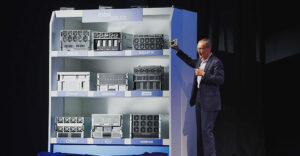
Over the last two weeks, I attended a huge HP lab event, watched Apple launch the iPhone SDK brilliantly, and saw one of the strongest consumer laptop lines launched by Acer. All three vendors are growing in the 30 percent range in the PC market; Acer just passed Dell for the No. 2 spot in the notebook market; and all three vendors have smartphone efforts in their infancy.
This leads me to believe there is a collision coming and that it might be fun to talk about each vendor’s strengths and weaknesses in the fight.
We will close with my product of the week, which could eventually capture much of what we now call the PC market.
HP: Broad, Green and Solidly Founded in Research
HP’s clear advantages in this fight are represented by its overall leadership in a number of related segments ranging from server lines all the way down to printers. The company has what appears to be the most capable of the remaining labs, which has undergone a significant change recently making it vastly more strategic to the overall business.
In addition, HP is the only large IT vendor to adopt the concept of green so deeply that it permeates all levels of the company to a degree that allows it to report a bottom-line operational financial benefit. This makes HP one of the most credible vendors on the topic in the segment.
Finally, HP has a PC design and marketing team that ranks with the best; and the best integration between focused gaming (read performance) resources with Voodoo PC and the rest of its PC business.
On the negative side is that the company is large and has had historic problems with internal politics and infighting. This makes HP less agile than it otherwise would be and has the tendency to distract executives from customers and competitors.
The company’s phone effort, which has its roots in one of the leading PDA businesses, has languished. It was easily bypassed by RIM on the corporate side and blown away by Apple on the consumer side. Finally, a huge portion of the firm’s resources are tied up with the printing unit which, while dominant in its segment, has been a huge drag on revenue growth and the firm’s valuation.
Acer: On the Ragged Edge
Acer is a channel master doing things in retail that feel like channel stuffing but constantly avoid the repercussions of that practice. Watching Acer in channel is like watching a good racing sail boat captain at work, sailing aggressively close to the edge of trouble (called the “ragged edge”) but evidently never crossing over the line. It avoids channel conflict like the plague and this combination has fueled impressive growth for a firm that, a few years ago, seemed about to fail.
Acer, too, has well-designed products and recently acquired Gateway and Packard Bell in a coup that had left Lenovo jilted at Packard Bell’s altar. It’s one of the most agile companies in the segment, and its Blue line borrows branding elements from Apple and technology from Dolby to create what is arguably one of the best-looking and distinctive lines in its class.
Finally, Acer is one of the few firms that understands how to make co-branding really work. The Ferrari laptop line remains one of the best examples of co-branding currently in any market.
On the negative side, Acer expertise is tactical — not strategic — and often aggressively jumps from opportunity to opportunity, many of which have been failures.
Of the three vendors, it has historically been the least effective at marketing and remains largely unknown, particularly in the U.S. Its aggressive channel behavior has alienated some key retailers in the U.S., which has made success in North America elusive. Additionally, the company just completed a double merger and now has three brands to manage, making it even more complex than HP in terms of brand management. At the same time, its lack of a gaming line makes its coverage of the PC segment less broad.
Apple: Marketing Genius
Apple is a world-class marketing company. One of the few firms in the world that truly builds marketing into a product from birth, Apple eclipsed all of the other consumer electronic vendors with the iPhone last year. This company has set the bar with regard to demand generation and often seems to embarrass Microsoft, a vastly larger and better-funded company, with its execution.
Showcasing one of the strongest grasps of what an ideal user experience is, Apple is often cited — both within and outside its segment — as an example of excellence. Packaging weaves into this, and from the moment they open an Apple product consumers know they are in for something positive and special.
Apple also takes more trouble to own the user experience, and their recent SDK program for the iPhone is unique in terms of how aggressively it attempts to assure this experience.
Finally, this company has what may be the most loyal group of users on the planet. Many of them have supported the company tirelessly through good and bad times and form an enviable sales and advocacy force for the firm.
On the negative side, there is an excessive reliability for Apple’s success tied to Steve Jobs who is capable of making big mistakes and is mortal.
Apple tends to sometimes focus too much on design and creates products that are high profile and impractical; the new MacBook Air and old Apple Cube are both examples. Its PC lines are one of the most limited, forcing customers into hard choices they wouldn’t have to make with most other vendors. Finally, Apple is so controlling that the reporters and analysts who cover the company often dislike it.
Acer, Apple, HP: Who Wins?
The answer may depend on Linux and/or Microsoft. HP has the most resources, Acer is the most agile and Apple is a demand-generation and user-experience machine.
HP is starting to match Apple in marketing and has a significant effort focused on the consumer experience. Acer is also doing substantial work on the customer experience and improving marketing, though it still lags behind HP and Apple. Apple is starting to identify replacements for Steve Jobs (who wasn’t that visible at the last Apple event). It also seems to be trying to broaden its lines but still significantly trails HP and Acer.
HP has the most resources and currently leads the market. Its biggest problem is internal, so I’d given this company the edge. Acer and Apple are well matched but Acer is willing to grow by acquisition and Apple isn’t yet (and it isn’t clear what it would acquire anyway, since it killed off its own clones). So I would expect Acer to continue to have a larger share than Apple — unless the mergers fail, which is certainly possible.
Now the real question is, can HP find a way to match Apple in user experience? That will either depend on Microsoft or Linux, with both options in play right now. Given Wal-Mart just pulled its Linux products, and Windows 7 is still some time off; does anyone want to bet if either of these paths will be successful in creating a true threat to Apple?
Product of the Week: Pandigital Kitchen TV/Digital Cookbook/Digital Photo Frame
I love class-busting products. The iPhone was actually a class-busting product; I think the Lenovo X300 and MacBook Air are class-busting products; and the Alienware m15x I spoke about last week is a class-busting product. These products give us a sense of what is to come and get us to think differently about a segment.
With this new Pandigital product, which desperately needs an iPhone-like name, you have what could begin a wave of new products that might actually eclipse the PC.
Basically this is a digital picture frame with enhanced features like HDTV capability and document navigation.
Future iterations could include casual gaming, Web navigation, K-6 education, automotive maintenance (the perfect thing for a car guy’s garage), and baby monitoring/parent education, and medical monitoring/entertainment (remote home care), to name just a few ideas.
At an initial US$400 entry price, largely tied to the dropping cost of the display itself, these things will be increasingly price attractive and provide an ease of use advantage that PCs — even Apple PCs — can’t currently match.
Seeing this product makes me wonder if an excessive focus on — oh, say, printing on paper — isn’t keeping some companies from seeing this opportunity and driving it. Regardless, the fact that the follow-on products that Pandigital Kitchen TV/Digital Cookbook/Digital Photo Frame will spawn, despite its name, will likely change the world is what makes this offering my product of the week.
Rob Enderle is a TechNewsWorld columnist and the principal analyst for the Enderle Group, a consultancy that focuses on personal technology products and trends.





















































